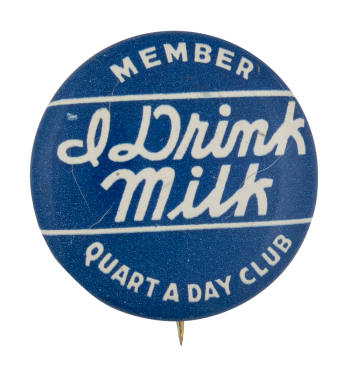| Category | |
|---|---|
| Additional Images | |
| Sub Categories | |
| Text on Button | MEMBER I Drink Milk QUART A DAY CLUB |
| Image Description | White text is centered betwen two horizonta lines with additional text on the upper and bottom edges on a blue background. |
| Back Paper / Back Info |
Back is litho stamped: Local No. 4 Amalgamated lithographers of America. Chicago IL |
| Back Style | |
| The Shape | |
| The Size | |
| Year / Decade Made | |
| Additional Information | Around midcentury, milk was viewed as one of humankind's most important foods. Advertisers and scientists alike had convinced the public that milk was a supremely healthy, nourishing, even life-giving substance. Its almost mystical whiteness was, for perhaps the only time in its history, matched by its hygienic purity and popular appeal. An article that appeared in the Tribune-Republican of Greeley, Colorado in September of 1932 explained the need for raising funds for milk for needy families. Becoming a member in the “Quart A Day” club means that a person will contribute funds to reduce the cost of milk for needy families. As a result of the Depression many unemployed families were in need of nutrients and milk was a critical source of nutrients. The Greeley nurses also explained that as the winter season approached the milk situation would become more serious. “Quart A Day” club members could finance a half-gallon or two quarts of milk for 80 or 76 cents per month. Other organizations such as the Woman’s Club would continue to support undernourished school children. |
| Sources |
"Milk in the Twentieth Century." Cambridge World History of Food. Cambridge: Cambridge University Press, 2000. Milk Fund. (1932, September). Tribune-Republican of Greeley, Colorado. 6. |
| Catalog ID | CL0006 |


